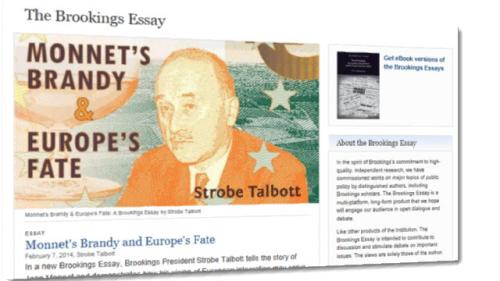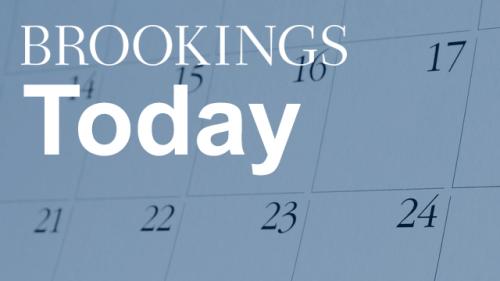Whatever you call it, “longform” online content “takes you on a journey in the way that maybe a short blog post or a tweet is not going to,” said New York Times Senior Graphic Editor Hannah Fairfield at a Brookings event last night on the future of longform publishing. John Dickerson, Slate’s chief political correspondent, moderated a panel discussion with leaders in longform publishing to discuss their experiences and plans for longform in the future.
Dickerson ( @jdickerson) led off the questions with the “elephant” in the room: “What are we talking about when we’re talking about ‘longform’”? he asked.
Chad Millman ( @chadmillman), editor-in-chief of ESPN The Magazine, called the term “just precious.” Longform, he said, “has existed for years, and it’s called storytelling, and magazines and newspapers have been doing it for decades.” But today, Millman, continued, when people consume media in much shorter bites, “longform sounds like it’s elevated” and so there are more of this type of content coming out. “I find the term unbelievably irritating,” he said.
“The most successful stories for us hit every platform.” Chad Millman
Fairfield ( @hfairfield) added that “Whatever you want to call it, I think what we’re talking about today is the kind of animal that takes a story that may be in length a little bit longer but certainly the kind of story that removes you from where you are sitting in your chair and it takes you on a journey in the way that maybe a short blog post or a tweet is not going to.” It’s about telling an immersive story, she said, and “we didn’t have those tools a couple of years ago.”
“Not every long story needs to or wants to or makes sense to have a design that’s built out with a lot of different elements.” Hannah Fairfield
Sarah Sampsel ( @sarahsampsel), director of digital strategy for The Washington Post, placed the emergence of longform in the context of competition for attention: “We’re competing against everybody now, because we’re competing for people’s attention and for people’s time because there is so much to look at.” Longform, she said, “is a different way of consuming something” and in an environment in which people have so much content coming at them, there is “something really therapeutic about having some time [to do] a really deep dive onto any subject.”
“The Internet looks bad. So when you see something that doesn’t look bad I think a lot of people [think] this might be something good.” Sarah Sampsel
Millman emphasized that “just doing something long doesn’t make it good.” Rather, using new tools—graphics, video, data—to push stories forward takes resources, commitment, and ingenuity, he said. Fairfield noted that deploying these elements in a story—the “best kind of collaboration” a newsroom can do in Sampsel’s words—is not decorating the story, but “pushing the storytelling forward.”
David Nassar ( @dfnssr), vice president for Communications at Brookings, described the similarities between the longform product at Brookings (The Brookings Essay), a think tank, and the media companies on the panel. “The kind of opportunities that you look for are the kind of opportunities that we look for,” he said. And “the challenges that we face are some of the same challenges that the traditional media faces in terms of pushing these article out.” No matter what the form is called, Nassar explained that “it’s given us an opportunity to tell stories in a way that without the platform we might not have been able to do” and to reach new audiences. Plus, he said, the Brookings Essay has “opened up people’s eyes to what’s possible to do with the kind of public policy content that we create in a way that people hadn’t maybe thought about before.”
“The pieces are built to take advantage of the social world and we work very hard to … make sure that they get spread around in a social way as much as possible.” David Nassar
After the panelists briefly discussed the process of creating longform content and also their views on audience-building, Dickerson turned the discussion to “the blue sky” of what the future will look like, what would make the longform experience better. He described using a Kindle for a more interactive experience with text, including highlighting and making comments, and having a “seamless relationship with the text across all your devices.” He asked,
Is there a game element to this kind of story telling that could be used, where there is actual participation in the narrative in some fashion? Is there a way that the author participates … in some incredibly interesting way that nobody’s thought about it yet?
Sampsel answered that “if a story merits something like that, it’s really important to really think outside the box about the ways to better connect with somebody.” Beyond even the longform format, Sampsel said that she is thinking of how content is synched across users’ devices, making the user experience easy, and giving content creators easy templates in which to build their stories. She described the paper’s “enterprise template” that is allowing more stories with visual elements. “The more we do them,” she said, “the better we get at them.”
Fairfield answered that in a conversation with her publisher, he said that Snowfall 2.0 wouldn’t “look anything like Snowfall. … The whole structure of it will be completely different.” We don’t know what that will look like, she said, but now “We’re in that interesting experimental phase.”
Millman said that the blue sky future is where ESPN’s writers are, in asking them, “Where is the next idea, where is the exploration taking you? And it’s taking the writers out of their comfort zone.” The next questions, he added, are, “What is the technology we have available, what is the platform we have available” to present those stories?
Dickerson asked Nassar if Brookings scholars are starting to think about whether they can do their work “in a longform way.” Nassar answered yes, and that having external and internal Essay authors “helped to widen the scope of what the piece can be” and that “we absolutely have authors coming to us with ideas now or coming to us earlier with reports and saying ‘can we do anything like what you do with the Essay for this piece’? And that’s a great place to be in.”
Listen to complete event audio below, which includes audience Q&A, or visit the event’s web page
for full video.



Commentary
What is “Longform” and Where Is It Going?
April 30, 2014